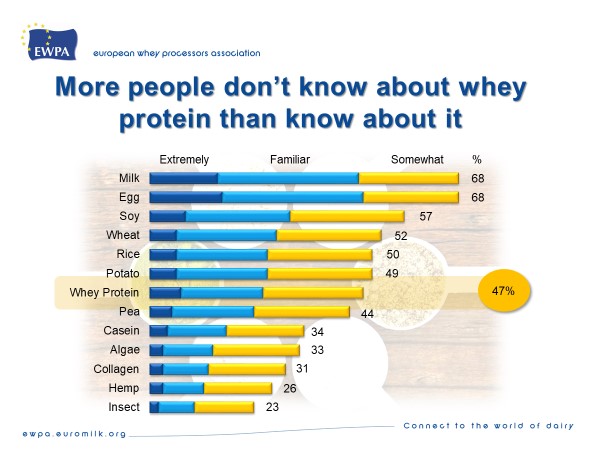There are many different sources of protein in the world, with more constantly coming onto the market. It’s hard to ignore, however, the growing number of studies that point to whey protein as the best to use for muscle maintenance and recovery. And that equally good results are emerging in a wide variety of other contexts, too, ranging from counteracting age-related loss of muscle mass in the elderly to the role of a high quality protein diet and weight management in overweight people.
But how many consumers are aware of the efficiency of whey protein as a lifestyle supplement? How many know its benefits and are able to put it to good use? Nowhere near enough, it appears. At least, that’s the conclusion of a study recently conducted by our organisation, the European Whey Processors’ Association (EWPA).
Exploring Europe
Let me list a few highlights of this large-scale (7,396 participants across eight European countries) survey, called the European Whey Protein Consumer Tracker and carried out by YouGov, an independent research agency:
- Participants identified themselves as interested in nutrition and/or taking physical exercise at least once a month
- They were asked about their opinion on protein, consumption patterns and purchasing behaviour
- 77% of respondents recognise that protein is an important part of their diet, yet almost 50% were unaware of the right quantity of protein to consume daily
- 25% proactively bought a “high protein” product in the last month
- Most recognise that there are differences among the protein sources
- Despite veganism trends in the EU, consumers continue to recognise the superior quality of animal proteins and dairy as a protein source
- Whey protein is more familiar than most ‘alternative’ protein sources, such as pea, algae and hemp proteins – but still relatively unknown

Time for a change
For us, the study’s finding that not enough knowledge exists among consumers about various protein sources, different protein products, their nutritional qualities and health effects, is one of the most important insights. And given everything whey protein has to offer the world, we believe this needs to change.
Of course, it’s likely that part of the problem is the fact that whey protein has long been seen as a commodity ingredient. Nowadays, it has acquired value in itself – and really, we’re only just beginning to find out more about what it has to offer.
Based on the survey results, and riding on a wave of scientific research and new processing capabilities, the EWPA is now working together with its members to identify strategies for spreading the word about whey protein. And we’ve already begun the effort, making information available on our website, presenting at the International Whey Conference (IWC) and Food Ingredients Europe (FIE) this year and providing materials members can use to bring the message to their partners and customers.
Naturally, the path to educating consumers is different depending on the countries. And the survey provided useful insights into the differences between consumers’ perception and habits among the eight EU countries. For example, over 60% of Polish and German consumers indicated that they consume whey protein, while among British and Dutch consumers this figure was 15 and 24%, respectively.
Exciting journey
There are a lot of efforts and resources going into this, so it’s time to make the most of it. Of course, we’re well aware that all this could be simply seen as an industry push to sell more product. But, in my experience, that wouldn’t reflect the attitudes of the whey protein producers I regularly encounter all over the EU. For them and their colleagues, working with whey protein is an exciting journey. They are part of a fast-evolving industry capable of addressing many of the world’s problems - and they’re keen to have many more people share the insights they have made.
It seems, however, that spreading the word may be easier than one might expect: once told what whey protein was, 80% of survey participants showed genuine interest – perceiving the product for what it actually is, a beneficial supplement to their lives. And that gets things off to a good start, I’m sure you’ll agree!
You can find more details of the European Whey Protein Consumer Tracker survey here.
This blog contains material and information intended for B2B customers, suppliers and distributors, and is not intended as information to the final consumers.


